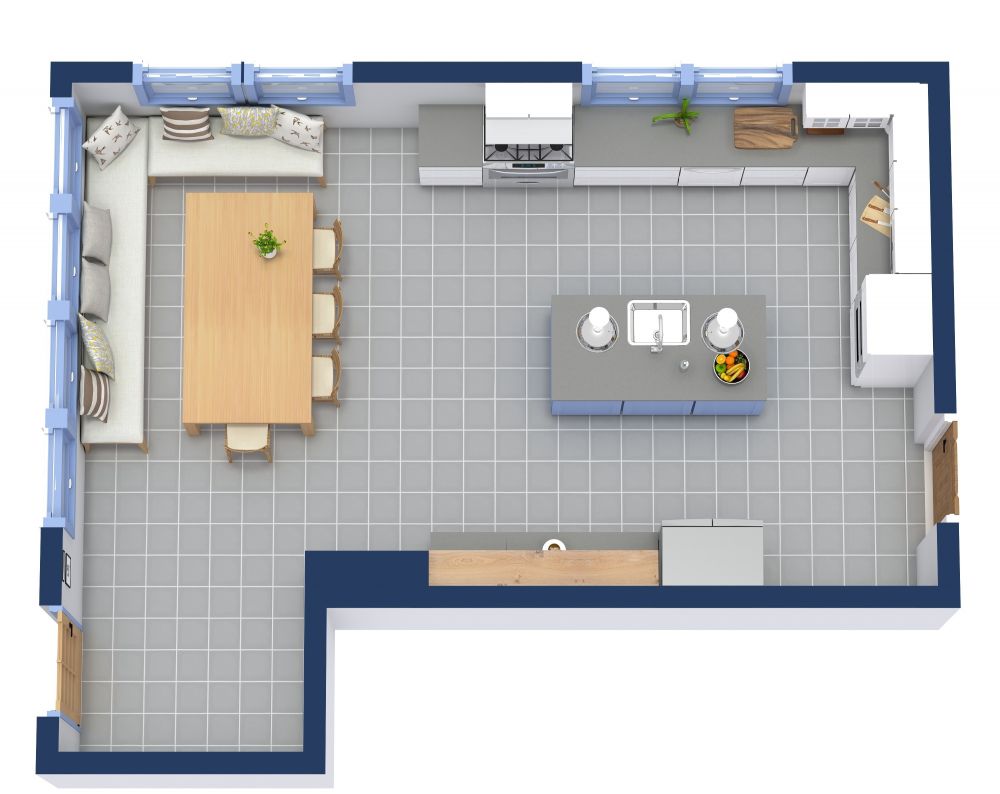Kitchen Floor Plan Templates
These days, many of us spend a lot of time in our kitchens. The kitchen has become a central hub for cooking, baking, socializing, working, or helping with homework. A well-planned kitchen designed around your lifestyle makes all your kitchen activities more pleasurable. So, if you’ve been dreaming of updating your kitchen and improving the layout, we’ve got lots of ideas for you.
Read More
Your Goals
Before you jump into browsing kitchen floor plans, it’s a good idea to think through your goals for the kitchen. An easy way to start is to jot down what you like and dislike about your current kitchen. Here are some useful questions to answer: Does the current layout work well for you? Do you need more counter space? Improved storage? What are the traffic patterns, and who uses the kitchen? Are there any new appliances you want to add, and what are their dimensions? What are your main cooking activities (baking, cooking, canning, etc.), and how well does the kitchen work for those? Are there other activities you want to achieve in the kitchen, such as a gathering place for friends or a homework hub for kids?
Kitchen Types
Kitchens come in many shapes and sizes, but many fall into a set of general categories. Here are some of the most popular layouts:
- U-shaped - A kitchen with three walls and an opening to the rest of the house is called a U-shaped kitchen.
- L-shaped - An L-shaped kitchen uses two perpendicular walls (in the shape of an “L”) for the counters and appliances.
- Island - A built-in kitchen island is popular in L-shaped, U-shaped, and single wall kitchens.
- Peninsula - A peninsula is an island attached to a wall or counter on one side.
- Galley - A galley kitchen has a counter, appliances, and cabinets on two walls, with a corridor running down the middle.
- Single wall - A single wall kitchen has the counter, appliances, and cabinets along one wall.
The Work Triangle
As you plan your kitchen floor plan, it’s essential to understand the “work triangle,” the relationship between the refrigerator, stove, and sink. For the best kitchen functionality, most designers recommend you draw a triangle between those three appliances, with the distance between them being from 4 - 9 ft (about 1.2 - 2.7 meters). In other words, you want them spread out a bit for good work and counter space, but not so spread out that it’s a long walk between them.
Code Requirements
Your city or local area will have specific guidelines and standards for residential buildings. Related to the kitchen, these usually include requirements for electrical, plumbing, and ventilation. There may be rules for the number and placement of electrical receptacle plugs, particularly near a water source such as the sink. You’ll also likely need to have separate electrical circuits for high-power-use appliances like your refrigerator or oven. There may be plumbing codes related to the dishwasher or kitchen sink. And cooking surfaces will have ventilation requirements, such as a vent hood. The bottom line - it’s a good idea to have an expert involved in your final kitchen layout.
Common Layout Mistakes
As you review floor plans and brainstorm your perfect kitchen layout, avoid these common mistakes:
- Poor circulation. You’ll likely want multiple people to be able to use the kitchen at the same time. Think through the ideal flow in your kitchen, don’t scrimp on aisle width, and spread out key work zones and popular areas.
- Too much open shelving. While open shelves are beautiful in pictures, make sure you’ve carefully thought through your storage needs. Open shelves are hard to keep neat. A few upper cabinets add a lot of storage and allow you to hide any clutter.
- Forgetting to plan for trash and recycling. Your kitchen can look so much nicer with an under-counter trash and recycling center rather than a visible trash can and recycling bin.
- Not enough counter space. Be sure to think through all of your needs and build in as much counter space as possible.
- Ventilation placement. If your cooktop is not against a wall, be sure that you’ve thought through how its ventilation will work.
Are you ready to create a beautiful and functional kitchen floor plan? Check out all our templates and get started today!